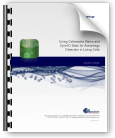Using Cellometer Vision and Cyto-ID Stain for Autophagy Detection in Living Cells
Our understanding of autophagy has expanded tremendously in recent years, largely due to the identification of the many genes involved in the process, and the use of GFP-LC3 fusion proteins to visually monitor autophagosomes and autophagic activity both biochemically and microscopically [1, 2]. Recently, a novel fluorescent probe, Cyto-ID® Green autophagy dye, has been developed to facilitate the investigation of the autophagic process [3-5]. In this study, a novel method was performed using the Cellometer image cytometry in combination with Cyto-ID Green autophagy dye for detecting autophagy in live cells. First, Cyto-ID Green autophagy dye was validated by observing co-localization of the dye and RFP-LC3 in HeLa cells using fluorescence microscopy. Next, image-based and flow cytometry-based methods are benchmarked for measuring macroautophagic signals in nutrient-starved Jurkat cells. Autophagic signals of starved Jurkat cells induced with an autophagy inhibitor were also quantified and compared using the two instrument platforms [6]. In order to establish the feasibility of employing the imaging-based workflow for drug discovery applications, a timecourse study of the induction of autophagy in Jurkat (suspension) and PC-3 (adherent) cells treated with rapamycin was undertaken [7, 8], demonstrating the ability to detect autophagy with a similar sensitivity as the starvation model. Finally, direct dose-response comparisons of two small molecule autophagy inducers, rapamycin and tamoxifen, were performed [9].

